The best protected Italian cruisers ? – The four Zara class cruisers for most authors and historians are the most famous, well-known Italian cruisers of the Second World War. Of course because they were in the other end of British barrel mouths at Matapan, but also due to their excellent design, allocating them the best protection possible for a heavy cruiser at the time, and probably one of the best in the world when launched. But they had also the dubious privilege, shared with USN New Orleans class in 1942, to lost three of their class in a single night engagement. Both were caused by surprise, almost without firing a shot. A single aerial torpedo was involved in their doom. But this fight was mostly unfair due to the lack of radar on the Italian side, the British achieved complete surprise and secured victory as no cruiser armour could stand British 15-in shells at such close range. The battle concluded also with one of the rear boarding actions of WW2, on Pola, and a controversy. Gorizia in repairs back then, would serve for another two years and see action at both battles of Syrta.
The battle of Cape Matapan was nevertheless quite a victory for the British, on par with taranto, in which it crippled three out of four of these heavy cruisers, the last of the Italian Navy. Zara, Fiume, Gorizia (launched 1930), and Pola (1931) which differed between them. They were nevertheless an evolution of the two Trento class but seeking better protection, like for the French Algérie. The London treaty signed in 1935, would cap the overall numbers of 8-in cruisers, and the Regia Marina turned towards “large light cruisers” like in other navies.
Design Development of the Zara class
[2100×666] Cross-section of a Zara-class heavy cruiser
byu/Historynerd88 inWarshipPorn
For the first time since 1920, the admiralty questioned speed. Until then, it was seen as a kind of active protection, but advances in ballistic computing and modern range finders was starting to negate this. A return to a better protection was then preferred by the rejuvenated staff of the RN, but this went against the Washington treaty limits and its 10,000 tonnes standard wall. Indeed more armour with the same armament, meant a reduction of speed and smaller dimensions as a way to mitigate this, but also a better protective scheme overall. These ships innovated on many points. Despite the lenght reduction of ten meters, the beam was unchanged to preserve stability. Lighter superstructures to decrease the roll, a more complex internal protective arrangement, and above all, the drastic reduction of the length of their citadel, giving them this silhouette, with much more closer turrets fore and aft, and long ends at the bow and stern. This also helped to save armour weight in the “all or nothing” design.
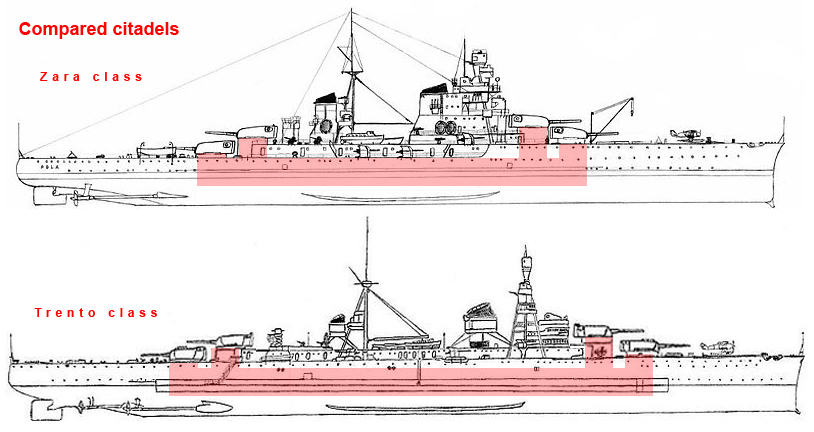
A comparison worthy of all speeches: Respective citadel size on Trento and Zara. The latter was 1/3 thicker, but on an obviously shorter section.
Displacement, fully loaded was 1,000 tonnes heavier than the Trento class, 14,300 tons versus 13,300 and the belt reached 6-in (150 mm) against of 70-100 mm. Still, that did not made them armoured cruisers, but at least thy can deal with confidence with any light cruisers or the dreaded French super destroyers. This made them superior as well to the French Duquesne and Colbert classes. The appearance of the Zara class was worrying for the French, which voted in January 1930 the construction of a new heavy cruiser of revised design, Algérie. Unfortunately for the latter, they also signed the Treaty of London and this ensured she would have no sister ships. This fact gave confidence to the Regia Marina staff in case of a confrontation with the French in the Mediterranean. But no plans survives the chaos of war.
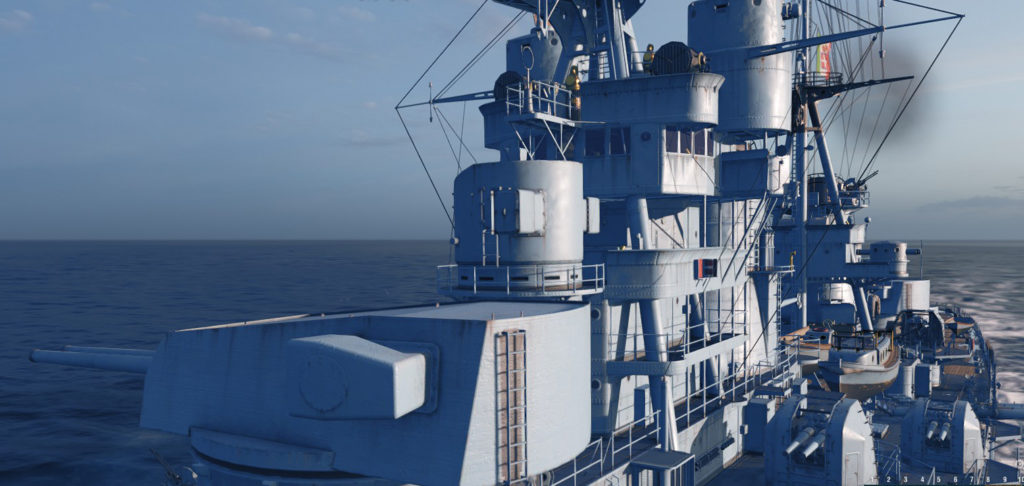
Design of the main bridge of Zara (wow)
The admiralty at first advocated for a near-impossible compromise, maintaining 32 knots (instead of 34-35) and its main armament, while having a 200 mm thick belt, so proof against 8-in shells. This more balanced design also vowed for a more comprehensive protection scheme overall. Designers of course found that these characteristics were hard to achieve, and can only be inserted in a 10,000 long tons design by radical innovations in order to save weight. The naval command “Supermarina” instructed designers to eliminate “unnecessary features” and eventually the belt armor was decreased, while the torpedo armament was omitted. It was also seen that eliminating the flush deck for a forecastle deck, stepped-down main deck would also helped to save weight. In the same vein, reducing the machinery overall weight by having just two propellers AND lightweight machinery was also a judicious choice. Boilers tech moved forward since the 1925 Trento, and it was now possible to produce as much output from smaller boilers and turbines. There was also if course the drastic length reduction of the citadel.
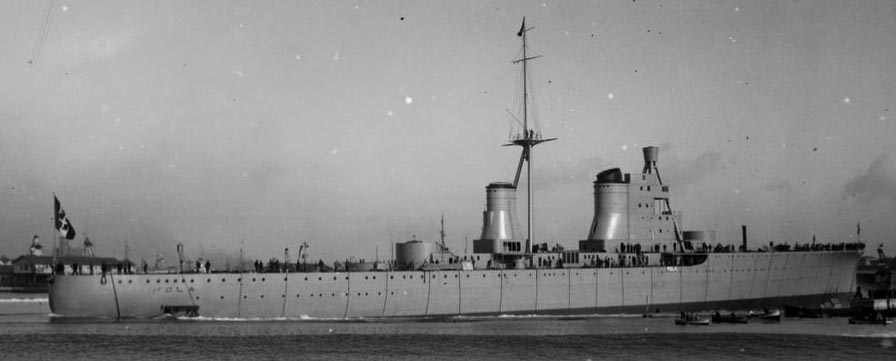
Pola completing in Livorno, 1931
Despite all of this, the Zara still exceeded the displacement limit by at least 1,300 long tons at least on paper in 1928. It was hoped not further additions would be made, and the regime planned to lie about their displacement anyway.
The first two, Zara and Fiume, were ordered as part of the 1928–1929 shipbuilding program, Gorizia in the 1929–1930 program, and Pola under the 1930–1931 program. As a propaganda gesture for the fascist regime, they were all named for former Austro-Hungarian cities annexed to Italy after World War I and contested by other powers, leading to the irredentist movement. However three were built at Odero Terni Orlando (OTO) of Muggiano, just one in Trieste (Stabilimento Tecnico Triestino) or STT in the space of three years down to two (for Pola).
Design
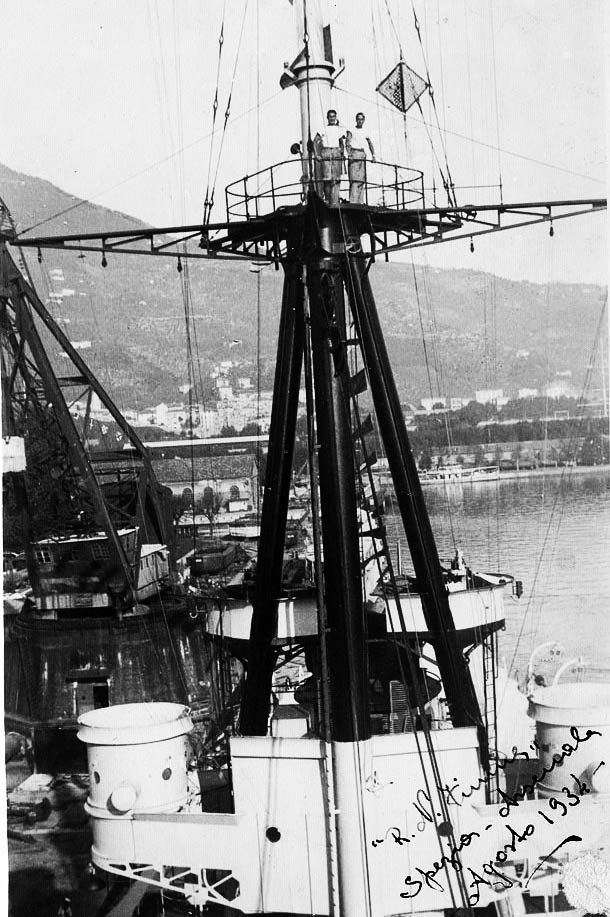
Main tripod mast aft
Hull
The Zara class had short hulls compared to the 190+ meters Trento class. They measured 179.6 meters (589 ft) at the waterline, 182.8 m (600 ft) overall, for a beam of 20.62 m (67.7 ft) and 7.2 m (24 ft) draft. So same beam, more draft, but 13 meters less in length. Standard displacement was superior, at 11,326 of Fiume and 11,712 long tons on Gorizia and fully loaded, up to 13,944 and 14,330 long tons respectively. The first three ships had light, narrow superstructures framed inside the three-legged main mast, saving weight. However it soon was seen as a problem, and Pola which was intended as a flagship was given a larger bridge to accommodate an admiral’s staff, with extended to the funnel behind.
Powerplant
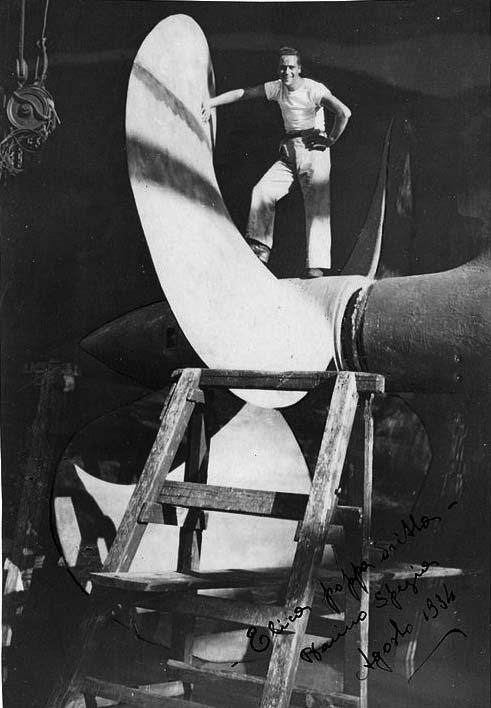
Engineers did not took more risky path for the powerplants like the Germans testing diesels, despite the obvious gain in weight, as they needed to reached 32 knots (59 km/h; 37 mph) as requested. But they opted for licence-built Parsons steam turbines, fed by eight “light” oil-fired Thornycroft boilers, and Yarrow for Fiume. Exhausts from the two engine rooms were trunked into two funnels of unequal size. Total output was 95,000 shaft horsepower (71,000 kW), reaching the desired speed. On sea trials these were exceeded at 118,000 shp (88,000 kW), reaching 33 to 34 knots (61 to 63 km/h; 38 to 39 mph), pleasing the admiralty which still had this operational “reserve” under the foot in case. In service of course it was reduced to a more manageable top speed of 31 knots, and 16 knots cruising speed. No excessive vibrations were registered as they were more strongly built and compact than the previous Trento. These cruisers carried 2,300 to 2,400 long tons (2,300 to 2,400 t) of fuel oil. This enabled a range of 4,850 to 5,400 nautical miles (8,980 to 10,000 km; 5,580 to 6,210 mi) at 16 knots (30 km/h; 18 mph), down to 1,150 to 1,900 nautical miles at full speed. The narrow confines of the Mediterranean Sea allowed to accept a shorter cruising range, contrary to the French which ships were also likely to be posted on the Atlantic and north sea as well.
Armament
There was no real surprise on this chapter, as it was defined long in advance to comprise eight 8-in guns (203 mm), and sixteen secondaries plus AA. The real surprise went from the absence of torpedo tubes.
Main artillery:
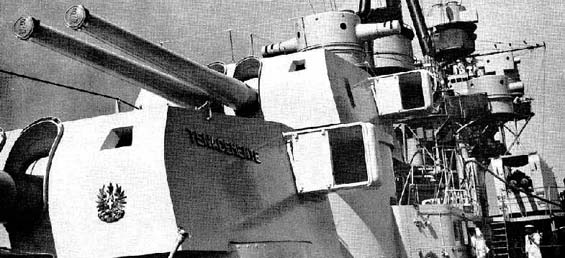
-Eight 203 mm (8.0 in) Modello 29, 53-caliber guns. They were placed in four gun turrets, arranged like the Trento in superfiring pairs fore and aft. They were a modernized version of the 203 mm (8.0 in) Mod 24 50-caliber guns of the Trento, with a better range at 31,500 meters (34,400 yd) versus 27,000 meters (30,000 yd) for the same elevation of 45 degrees but more powerful propellant charges and greater initial velocity.
The shells weighted 125-kilogram (276 lb), and had a muzzle velocity of 940 meters per second (3,080 ft/s). 157 shells per gun meant a total of 1,256. Rate of fire was 3.5 rounds per minute. The number of shells carried needs to be put in comparison to their general performances: This was notably due to the inability to create separated barrel mounts. Both were mated to the same cradle, and could not elevate separately. This cause also a dispersion problem, as both were too close together and interfere with each other due to massive turbulence (each shell was red hot when exiting the barrel and tended to dilate the air around, naturally pushing each other apart. To mitigate this, engineers found two solutions: Having a delayed firing for each gun, less than a second, and modified shells capable of a lower muzzle velocity of 900 meters per second. The second problem was due to poor factory quality control: The shells failed to adhere to strict caliber tolerance, which created unequal pressures in the barrel, ending with not accurate shells. This was shown time and again in combat.
AA artillery:
This was a four fold pyramid, or “defence bubble” around the ship:
-Sixteen 100 mm (4 in) 47-cal. dual pupose guns: Basically copies of 1910 Austro-Hungarian guns from Škoda placed in new DP mounts elevating to 85°, range 15,240 m (50,000 ft)
-Four single Vickers-Terni 40 mm/39 guns: Derived version of the Škoda guns, comparable, but less effective than Bofors. Already obsolescent in 1932.
-Eight (4×2) 13.2 mm (0.52 in) twin Breda mounts. Quick but short range weapons, lacking punch.
The gap between machine guns and the 40 mm was quickly detected and led to armament revisions before and during the war.
Modifications:
-1938: The two aft most broadside 100 mm guns were removed as well as the 40 mm guns in 1937-39. Eight 37 mm (1.5 in) Breda 54-cal. guns were installed in twin mounts instead, two twin on either side of the after superstructure in place of the 100 mm aforementioned.
-1940: Two 120 mm (4.7 in) 15-cal. star shell guns added for night operations.
-1942, Gorizia’s star shell guns replaced with four additional 37 mm guns (2×2).
-1943: Still on Gorizia, fourteen 20 mm (0.79 in) guns (six twin, two single mounts) were installed, replacing the obsolete 13.2 mm HMGs.
Onboard aviation:
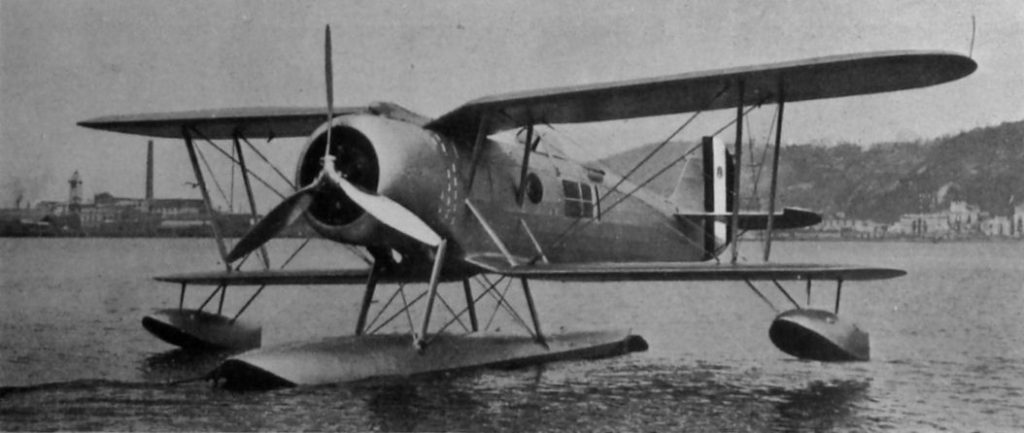
Without radar, these ship’s reconnaissance and artillery corrections relied to floatplanes: They carried each a pair of IMAM Ro.43 seaplanes. The hangar was situated under the forecastle. They were served by a fixed catapult mounted on the centerline, at the bow. While it was an hinderance for deck work and frequently “wet” there was no room anywhere else along the superstructure, which were concentrated in the center of the ships. In 1943 tests were made with ore offensive planes like the Capronia-Reggiane Re-2000 able to carry a bomb or an aerial torpedo.
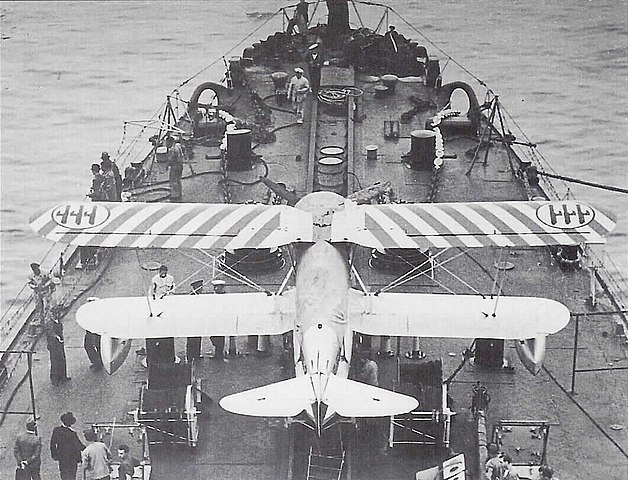
IMAM Ro.43 launched from the fwd deck catapult.
Protection: The ace card
The Zara class were protected with a shorter armored citadel as we have seen, covered the ships’ vitals, topped by the armoured deck. The machinery spaces and ammunition magazines were well protected compared to all and every cruiser of the 1930s, in fact, the Zara class ended as the best protected cruisers in the world prior to the introduction of the Des Moines class in 1947 !.
-Vertical: Armored belt 150 mm (5.9 in) thick, tapered down to 100 mm (3.9 in), bottom edge of the waterline belt.
Armored bulkheads 120 mm (4.7 in), upper portion, 90 mm (3.5 in) lower one.
-Horizontal: Main armor deck 70 mm (2.8 in) thick + 20 mm (0.79 in) upper deck to detonate fuses.
The connection between the lower and upper comprised slopes 30 mm (1.2 in) thick.
-Gun turrets: 150 mm plating (faces), 100 mm sides and back.
-Barbettes: 150 mm thick above the deck.
-Main conning Tower: 150 mm walls, 80 mm (3.1 in) roof.
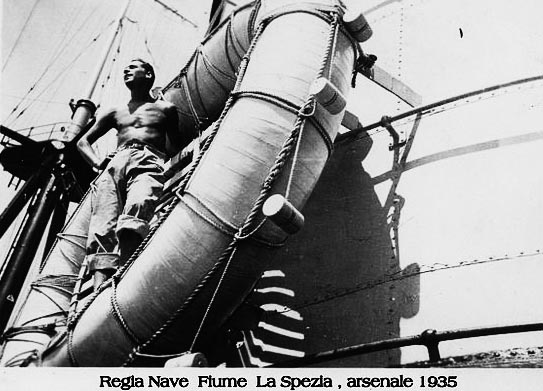
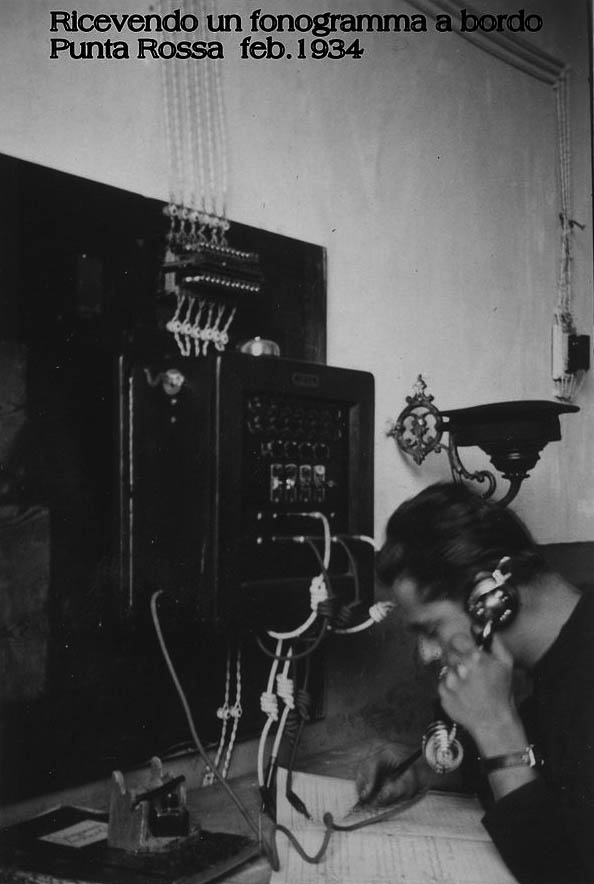
Fiume in La Spezia: Safety inflatable boat, and radio room.
The perfect match: Zara vs Algérie
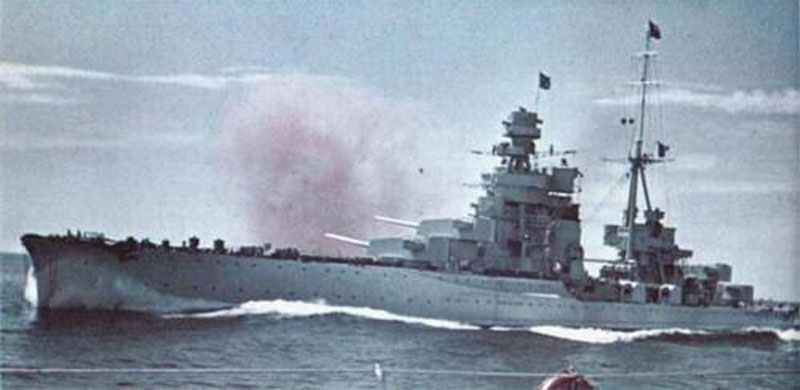
Colorized photo of Zara at Punta Stilo (comandosupremo.com)
We can only guess how a duel between a Zara and Algérie would lead to:
-In terms of main armament, both were evenly matched, although the French could elevate their barrels independently.
-In terms of secondary armament, the French had an advantage in number, with twelve versus eight dual purpose 100 mm guns.
-The Italians had a better AA, but no torpedo tubes.
-Both had seaplanes, but Algérie had three of them, perhaps able to locate the Italians first.
Now in the duel at long range overall, the French design was clearly weaker in armour thickness.
-French Figures for bulkheads to the CT were between 70 and 95 mm (3-4 inches), 120 mm (5 inches) for the Belt.
-The Zara class had 150 mm (6 inches) overall, and slightly thinner armoured deck (70 mm versus 80 mm), so the French would have a slight advantage in long parabolic, long range artillery contest, but against an armour-piercing capped 8-inches shell, 10 mm would not made much difference.
At closer range, the Zara would have been much more efficient. The rest would be in the hands of the meteorology, general condition of each ship and of course its captain, with slightly more speed to the Zara to out-manoeuver its opponent.
So the “bad rep” of the Zara, and conversely the Algérie branded as the “best washington treaty cruiser” is not doing them justice. We can see here a much maligned class of cruisers, victims of circumstances of war. Indeed, in wartime and with almost a 5,000 tonnes more displacement, so 1/2 more, the Baltimore class had about the same armour figures, at 6 to 6.5 in, with the exception the the turret faces, protected by 8 in.

Heavy Cruiser Algérie
Technical specifications
Displacement 11,680 tons standard -14,300 tons Fully Loaded
Dimensions: 182,80 m long, 20,62 m large, 7,20 m draft
Machinery: 2 shaft Parsons turbines, 8 Thornycroft boilers, 95,000 hp.
Top speed: 32 knots
Protection: Belt 150, decks 70, turrets 150-120, CT 150 mm
Armament: 8×203 (4×2), 6×100 (8×2), 6×40 AA, 8×13.2 AA
Crew: 880
Links/Read More
Sites:
http://www.regiamarina.net/detail_text_with_list.asp?nid=71&lid=2&cid=2
https://en.wikipedia.org/wiki/Zara-class_cruiser
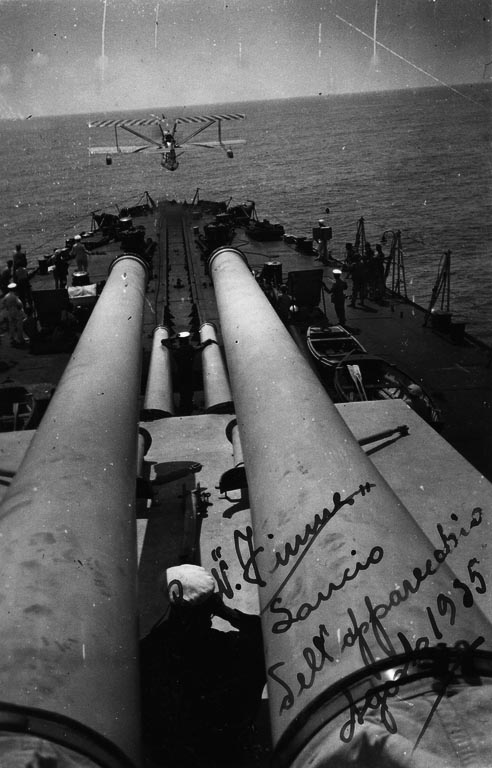
Fiume launching its floatplane, seen from the main upper turret (cropped postcard)
Books:
Brescia, Maurizio (2012). Mussolini’s Navy: A Reference Guide to the Regia Marina 1930–1945. Barnsley: Seaforth. ISBN 1-84832-115-5.
Campbell, John (1985). Naval Weapons of World War II. Annapolis: Naval Institute Press. ISBN 0-87021-459-4.
Cernuschi, Enrico; Brescia, Maurizio; Bagnasco, Erminio. Le Navi Ospedale Italiane 1935–1945. Albertelli. ISBN 88-87372-86-1.
Fioravanzo, Giuseppe. La Marina italiana nella seconda guerra mondiale. II – La guerra nel Mediterraneo – Le azioni navali – Tomo Primo: dal 10 giugno 1940 al 31 marzo 1941. Rome: Ufficio Storico della Marina Militare. OCLC 561483188.
Fitzsimons, Bernard (1977). Illustrated Encyclopedia of 20th Century Weapons & Warfare. 24. London: Phoebus. ISBN 0-8393-6175-0.
Friedman, Norman (2008). Naval Firepower: Battleship Guns and Gunnery in the Dreadnought Era. Annapolis: Naval Institute Press. ISBN 978-1-59114-555-4.
Gardiner, Robert & Chesneau, Roger, eds. (1980). Conway’s All the World’s Fighting Ships, 1922–1946. Annapolis: Naval Institute Press. ISBN 0-87021-913-8.
Greene, Jack & Massignani, Alessandro (1998). The Naval War in the Mediterranean, 1940–1943. London: Chatham Publishing. ISBN 1-86176-057-4.
Hogg, Gordon E. & Wiper, Steve (2004). Warship Pictorial 23: Italian Heavy Cruisers of World War II. Flowers, T. A. (illustrator). Tucson: Classic Warships Publishing. ISBN 0-9710687-9-8.
Martin, Stephen (1988). Grove, Eric (ed.). Sea Battles in Close-up: World War 2. Shepperton: Ian Allan. ISBN 0-87021-556-6.
O’Hara, Vincent P. (2009). Struggle for the Middle Sea: The Great Navies At War In The Mediterranean Theater, 1940–1945. Annapolis: Naval Institute Press. ISBN 1-59114-648-8.

Differences between all four cruisers (shipbucket). see also
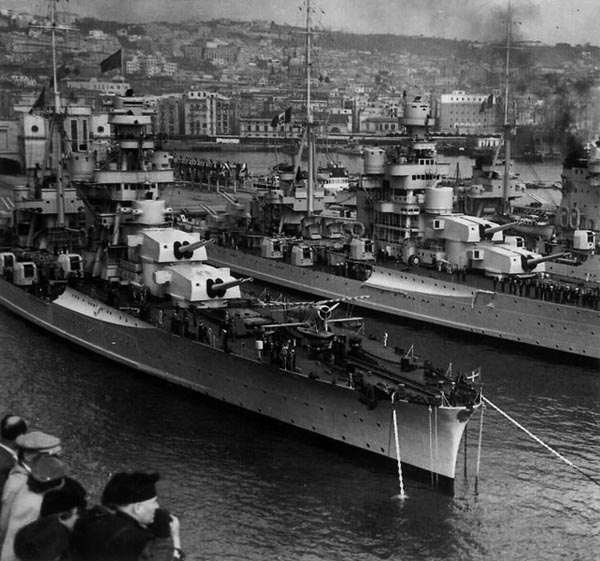
Zara and Fiume showing their different bridges, in Naples (comandosupermo.it)
Some original footage about the Zara (Luce)
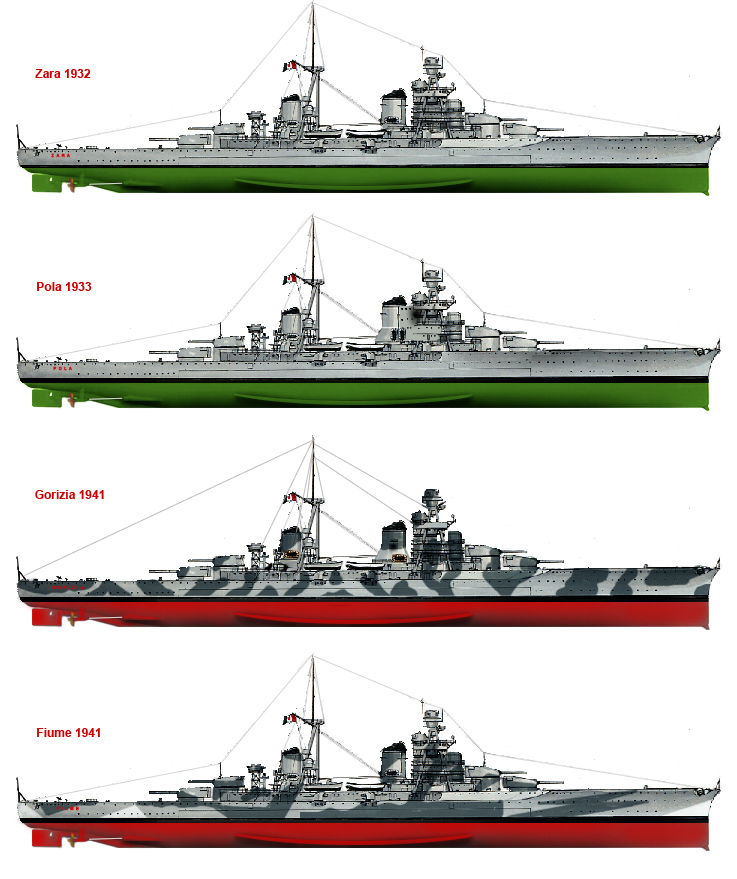
Author’s profile of the Zara as commissioned, Pola in 1933, Gorizia and Fiume in 1941.
The models corner

-Trumpeter’s Zara, pola, Fiume, Gorizia (1943 for the latter) 1:350, probably the best detailed so far
Scalemate results
And books: Kagero ed. “The Italian Heavy Cruiser Pola” Author: Carlo Cestra; POLA by Author: Sławomir Brzeziński, Editor BS Firma Wydawniczo-Handlowa.
The Zara class in action
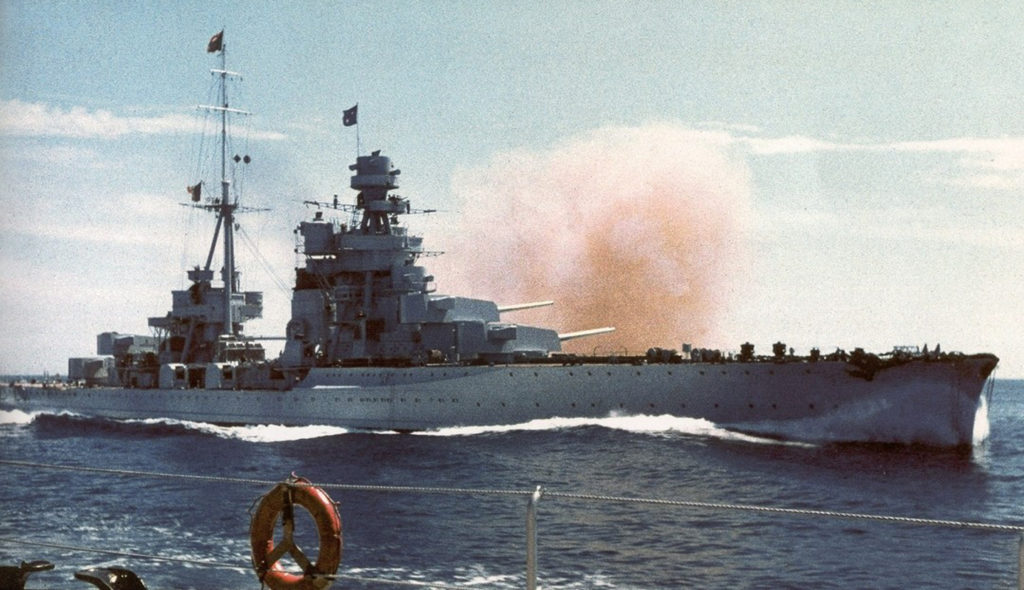
Colorized photo of Zara at Punta Stilo (comandosupremo.com)
All four were therefore sunk during the war: Zara, Pola and Fiume during the fatal night of March 29, 1941 off Cape Matapan, and Gorizia in June 1944 by ‘chariots’ used by Free Italians to avoid its capture by the Germans, in La Spezia. See the Battle of Cape Matapan Engagements: Invasion of Albania, Battle of Calabria, Battle of Cape Matapan, First Battle of Sirte, Second Sirte (GORIZIA).
Zara
Zara was started in 1928 at Odero-Terni-Orlando (OTO) shipyard, the first of three built there. The famous yard of Northern, industrial Italy was based at Muggiano, La Spezia (Ligurian coast). Launched on 27 April 1930, completed on 20 October 1931 she made her sea trials, reaching 35.23 knots on forced machinery (120,690 shp), more to break a record than representative of real service speeds. In standard conditions, fully loaded and in a moderately formed sea, maximum speed observed was more in the order of 29 knots. When commissioned, she was presented with the battle flag in her namesake city, Zara (now Zadar in Croatia).
From August 1932, she took part in her first fleet training exercises, in the Gulf of Naples. She later hosted King Victor Emmanuel III and became flagship of the First Naval Squadron by September. In July 1933 she took part in a naval review held for Benito Mussolini in the Gulf of Naples, and another review on 27 November 1936 with Victor Emmanuel III and prince Umberto II present as well as Mussolini, and their host, the Regent of Hungary, Miklós Horthy. All also came on board. Another fleet review on 7 June 1937 was held for German Field Marshal Werner von Blomberg, minister of defense and on 16 September 1937, she passed on her flag to the modernized battleship Conte di Cavour. Last peacetime naval review was on 5 May 1938, in front of Adolf Hitler.
She made her only mission in the wake of the Spanish civil war on 7 March 1939, as part of the division. She left Taranto to intercept a squadron of Republican warships fleeing the Nationalists takeover: It was three cruisers and eight destroyers strong. This fleet attempted to reach the Black Sea and friendly USSR. The italians held their fire but tried to impede their progress, forcing them to dock at Augusta in Sicily. But the Spanish commander refused and proceeded to Bizerte (French Tunisia) instead. There, his ships were interned. On 7-9 April 1939, Zara supported the Italian invasion of Albania and was back in Genoa for Navy Day, 10 June. The year 1939 passed without other incidents of notable events, Italy only went at war in June 1940.
Operations of 1940:
From 10 June 1940, Zara was mobilized as part of the reorganized 1st Division, 1st Squadron, as flagship (Rear Admiral Matteucci). The 1st division of cruiser (Gorizia, Fiume four Oriani-class destroyers) was based in Taranto and started to patrol off Crete. From 11–12 June, they were attacked by an unknown submarine, which missed, but the destroyers failed to sink it. On 21 June, Zara with division sailed to Augusta in Sicily, ready to intercept Allied convoys, in particular French troopships to North Africa. The 1st Division patrolled with the 2nd and 3rd Divisions, but never spotted any convoy. Zara took part next in the Battle of Calabria (Punta stilo) on 9 July: The engagement had been called later “Lots of Bark but No Bite” as it was largely indecisive. Basically it went when the Italians led to convoy to Libya, two torpedo boats escorting several steamers carrying 2,200 troops, 71 M11 tanks, 231 vehicles, 5,720 tons of fuel, and 10,445 tons of supplies. En route it was joined by a large fleet led by Admiral Inigo Campioni in which the 1st division of cruisers participated. Admiral Cunningham on the other hand committed force B and Force C, with three battleships (Warspite, Malaya, Royal Sovereign) and the carrier Eagle, and Campioni at fisr tried to lure out the British closer to an Italian airbase. The 1st Division engaged British cruisers arrive din reinforcement, Fiume opening fire first on HMS Liverpool, soon joined by Zara, Bolzano, Pola, Gorizia and Trento. Bolzano was hit three times by HMS Neptune, but Zara emerged unscaved. At 16:02 the Italians folded up under the conver of smoke, and withdrew to Messina.
On 30 July, the 1st Division escorted a convoy to Benghazi and Tripoli. In August, Gunnery training followed off Naples and at the end of the month, the division left Naples for Taranto. On the 31 September, it made a sortie of interception for a British convoy (Operation Hats) but failed to spot them. Zara was present during the Attack of Taranto during the night of 11–12 November. The few swordfish planes concentrated on the battleships, so she ws left unattacked and undamaged. The Italian command decided afterwards to disperse the fleet and Zara was sent to La Spezia for a periodic maintenance, until 9 December. She sailed for Naples which was bombed by the RAF four days later and she had to flee again to La Maddalena (Sardinia), arriving on 15 December, to be back in Naples on the 19th, and then Taranto on the 22. Admiral Carlo Cattaneo became the new commander of the division and started training exercises with Gorizia in January and February, later with Pola as well, and Fiume. In March 1940, artillery training was done in the Gulf of Taranto and Pola replaced Gorizia as flagship of the 1st Division, as she had been tailored for this role during construction. It became late the 3rd division.
The Battle of Cape Matapan
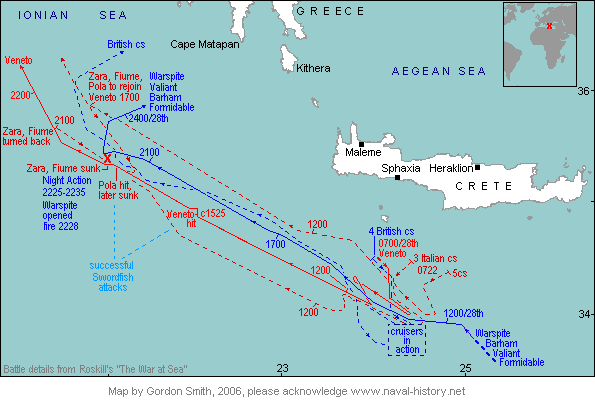
Scheme of the battle (cc)
The famous battle which decimated the 3rd cruiser division started as another attempt to intercept a British convoy, in the eastern Mediterranean. It was spotted south of Crete, by late March.
In the battle order, on the italian side (Iachino) the was a battleship (Veneto), 6 heavy cruisers of both divisions, 2 light cruisers and 17 destroyers. This was heavenly matched by Cunningham and his single aircraft carrier, 3 battleships, 7 light cruisers and 17 destroyers. There was an action off Gavdos, Veneto firing first on Admiral Pridham-Wippell’s cruiser group, but without much results, only splinters and showers of water splashed, notably on HMS Gloucester. This was followed by a night action, this time decisive. The 3rd Division was stationed on the disengaged side of the Italian fleet and did not see action but soon Vittorio Veneto was torpedoed by aircraft from HMS Formidable and had to withdraw. The 3rd Division screened the port side of the Italian fleet and there was another air strike on the 28, failing to locate the Vittorio Veneto, but they found the cruiser division. They attacked and soon one scored a hit on Pola, amidships and starboard side. She stopped and was soon immobilized, her teams rushing repairs. Iachino was later informed of Pola’s desperate situation around 20:10 and fatefully detached Zara, Fiume, and four destroyers to protect her until she was able either to steam away or to be towed to safety.



They were completely unaware that HMS Orion mea,while had detected Pola by radar, reported her and soon the Valiant, Warspite, and Barham closed in. At 50 nmi (93 km; 58 mi) they picked up the division by radar, closed in until they were ready to fire. At 22:10, they lighted up their projectors and immediately found the Pola, Zara and Fiume at around 6 nautical miles. The Italian lookouts spotted shapes approaching, assuming they were Italian vessels, going as far as firing a red flare to guide them. Twenty minutes later, the British line was so close the ships could be reoignised with ease, and they illuminated Zara the first, then Fiume and opened fire. Zara and Fiume were literally obliterated ad well as two destroyers. This was more a point-blank execution than a fight. Zara took no less than four broadsides from HMS Warspite, five from Valiant in the matter of 4-5 minutes. As she was burning and listing, HMAS Stuart closed in an launched torpedoes, followed by HMS Havock. Still after the British battleships turned away to avoid a torpedo attack from remaining Italian destroyers, Zara, remained afloat. She drifted near Pola and her commander decided she could not be saved, ordering to scuttle her. HMS Jervis meanwhile has returned to see if the cruisers were still afloat, spotted and then closed in with Zara, firing a volley, of which three torpedoes hit Zara, and she sank in ten minutes, carrying with her 783 men including captain Cattaneo.
Fiume

The only cruiser of this class not built at OTO but Stabilimento Tecnico Triestino (Trieste) because she was ordered at the same time as Zara, Fiume was in fact laid down earlier, on 29 April 1929, launched a year later in April 1930, same day as Zara, and fitted-out work to be commissioned on 23 November 1931. Nothing notable happened since her entry into service, fleet exercises gunnery training, ports visits, naval review, and by January 1935, autogyros were tested on board, using a wooden platform at the stern, successful experiments. Nevertheless, these autogyros were considered unreliable and had a too short range for effective service in the Regia Marina, the experiment was terminated. Fiume took part in a grand ceremony and parade held for the visit of Adolf Hitler in May 1938, making a gunnery demonstration observed from Conte di Cavour.
When war broke out for Italy in June 1940, Fiume was in the 1st Division with her sister ships and four destroyers (9th Destroyer Flotilla), part of the 1st Squadron (Inigo Campioni). They made a sortie in response of British attacks on Italian Libya, and were spotted en rout and attacked (but missed) by the submarine HMS Odin. On 7 July, a British cruiser squadron was spotted arriving in Malta while an italian convoy departed a day before and Supermarina (the high command) ordered the 1st Division to rush and join the escort. Conte di Cavour and Giulio Cesare were also scrambled to provide distant cover and two days later, this generated the inconclusive action off Calabria.
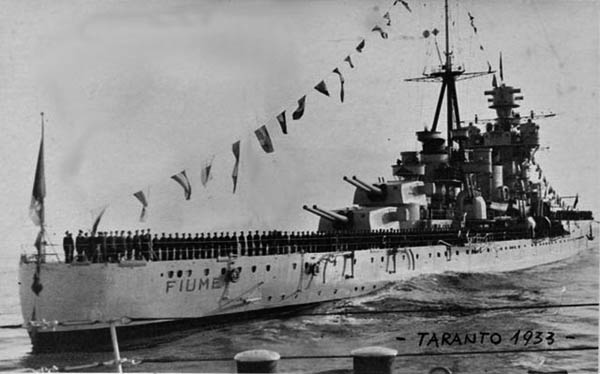
Fiume’s stern view
By late September, Fiume made a sweep with her division, searching for Operation Hats convoy, without results and in November she was in Taranto during the night time carrier strike, but was not targeted and she was reaffected elsewhere for a time. She was back to another intercept attempt of a British convoy by late November: The Battle of Cape Spartivento. This happened on 27 November for about an hour. At 12:22, both leading cruiser forces came into range. Fiume opened fire first, at 23,500 metres and the distance closed, and by then Italian firepower started to be more accurate. The situation changed with the arrival of HMS Ramillies, but she was soon distanced. The Italian cruisers outgunned the British and could have prevailed, if Vice Admiral Angelo Iachino had not received orders to disengage and ordering a general withdrawal under a cover of smoke. This decision was mostly the result of poor aerial reconnaissance. Fiume likely hit HMS Berwick twice, possibly helped by Pola.
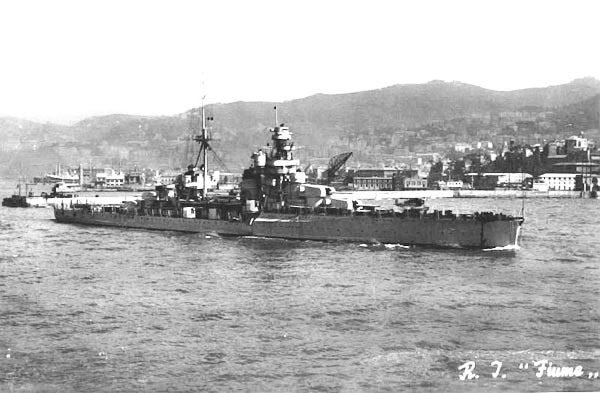
Fiume underway
Fiume, like Zara and Pola met her fate at the Battle of Cape Matapan. We will not delve in the details of it, as it was covered above and in more detail in the dedicated page. Basically Fiume was detached by Iachino, with Zara to escort the stranded Pola to safety. Spotted by radar, a British battlefleet, sneaked in and lit up the scene at 10:27 PM. Warspite was leading. Fiume was illuminated at 2,900 yards (2,700 m), and took a salvo of six 15-inch (380 mm) shells from Warspite, five hits which caused very serious damage: Fiume’s superfiring rear turret was blown overboard and her superstructure crippled. A second salvo followed, and Warspite was joined by Valiant after they dealt with Zara. Fiume was transformed into a burning wreck, not firing a short in response. She was spared further destruction however, as both battlehips went back to Zara. The Italian heavy cruiser eventually fell out of line and listed badly to starboard, but still she remained afloat for 45 minutes. After which she capsized and sank, stern first at 23:15. The battleships had battered the three cruiers for about three minutes, making short work of the cruisers with their 15 inches (381 shells), reputed as the heaviest, hardest-hitting in the world at that time. Not armour, at such distance, could absorbe such punishment. Fium sank rapidly, carrying with her 812 men including Captain Giorgio Giorgis. A few survivors were picked up by British destroyers after dawn, and Greek destroyers in the evening, and the remainder by the Italian hospital ship Gradisca the following days.
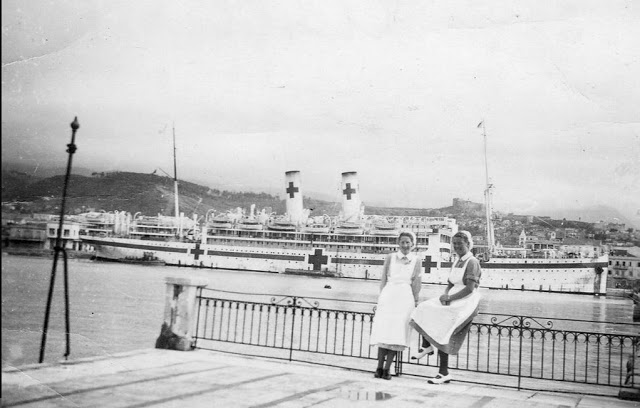
The Hospital ship Gradisca in Patras, Greece.
Pola
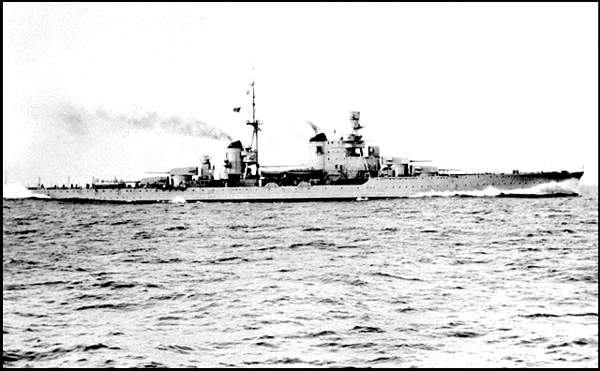
Pola, official sea trials photo
Pola, named after the city on the Adriatic coast of the former Austro-Hungarian Empire, was laid down at OTO Livorno on 17 March 1931, launched on 5 December, and was in service quickly, on 21 December 1932. She was affected to the 1st division, 1st squadron, and was fitted as a flagship, the only one with an extended bridge (which was narrow) and upper command deck. Pola participated in a naval review in the Gulf of Naples in presence of Benito Mussolini in July 1933 and the next year was formally given her Pola battle flag. By September 1936 she left Gaeta to patrol Spanish waters and non-intervention patrols. Between 10 September-3 October she was based in Palma de Mallorca and returned to Gaeta afterwards. On 10–12 March 1937 she operated off Libya, hosting Mussolini and Prince Luigi Amedeo. In June, she was in another naval review in the Gulf of Naples for Werner von Blomberg and in May 1938 again for Hitler during his state visit to Italy. On 7 March 1939, the division forced a squadron of Republican warships to dock in Sicily but the commander instead sailed to Bizerte to be interned. By 7–9 April 1939, Pola provided gunfire support for the landings in Albania.
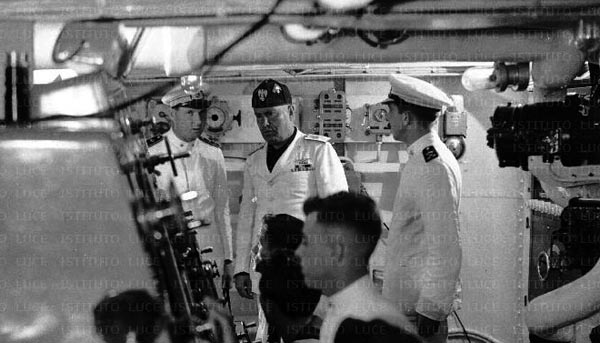
Mussolini and Prince Luigi Amedeo aboard Pola in March 1937
Pola became flagship of her division as planned, with Admiral Riccardo Paladini on board, as commander of the 2nd Squadron, comprising also thee Trento, Trieste and Bolzano (2nd Division) and the three light cruisers in the 7th Division plus seventeen destroyers. Pola escorted minelayers disrupting French sea lanes during the night of 10–11 June, refuelled at Messina. Her unit made a sortie to intercept a convoy on 6 July, which later transformed into the first large naval action in the Mediterranean, off Calabria. Pola engaged British cruisers but did not scored any hit. On 30 July-1st August, she was with Trento and Gorizia escorting a convoy to Libya. On 16 August, gunnery trained off Naples, and was later based in Taranto. After an unsuccessful sweep for a British troop convoy to Malta, she hosted Mussolini in Taranto. Pola was not targeted by British Swordfish during the night attack in the port. She left for Naples afterwards, and took part in the Battle of Cape Spartivento. According to some sources she landed two of her main guns shells on the British cruiser HMS Berwick, disabling one of her main battery turrets, but some authors argued this was by Fiume. Campioni broke off the action nevertheless because of bad intel, depriving the Italian cruisers of a possibly easy victory.
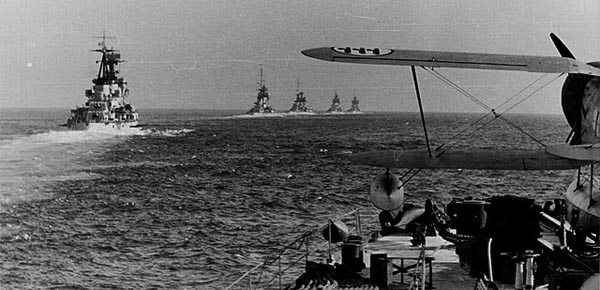
Fleet manoeuvers of the cruiser division
As the Italian fleet was reorganized on 9 December, Pola was affected with Zara and Fiume in the 3rd Division, 1st Squadron (Admiral Angelo Iachino). On 14 December, she was in Naples when the RAF attacked. She took near misses and two bombs hits, both amidships, port side. Three boilers were damaged and flooding followed, with a list to port. She was drydocked on 16 December, until 7 February 1941, missing exercises and sorties, before returning to Taranto on 13 February, joining Zara and Fiume. They preformed extensive maneuvers together in March, followed by a nighttime training operation on 23–24 March.
Immobilized by an aerial torpedo
On 27–29 March, Pola became the centerpiece of the drama that unfolded at Matapan. For most of the daytime engagement, the 3rd Division was not engaged. After Vittorio Veneto, torpedoed, withdrawn, a second wave of British aircraft from HMS Formidable searching for the battleship failed to locate her and instead fell on the fleet’s screening force, the 3rd division, on the port side. This airstrike mostly failed, scoring a single successful torpedo hit, on Pola. The light aerial torpedo, 457 mm (18 in) was enough to torn away the longitudinal bulkheads, below the belt amidships, starboard side. It happened just as Pola manoeuvered furiously to avoid these torpedoes, nearly colliding with Fiume. The flooding was quick and forced the ship to stop after an entire boiler room was inundated. She could no longer take evasive action and captain C.V. Manlio De Pisa considered his options. Meanwhile, after exchanging messages, the rest of the fleet conformed to orders and kept their flanking position, leaving Pola behind, her crew hard at work to repair the damage. Three compartments were underwater five boilers out of action, the main steam line shit down. She was effectively stopped dead in the water and the loss of power even immobilized her main guns in case British ships were closing in. There was the danger also of another air attack.
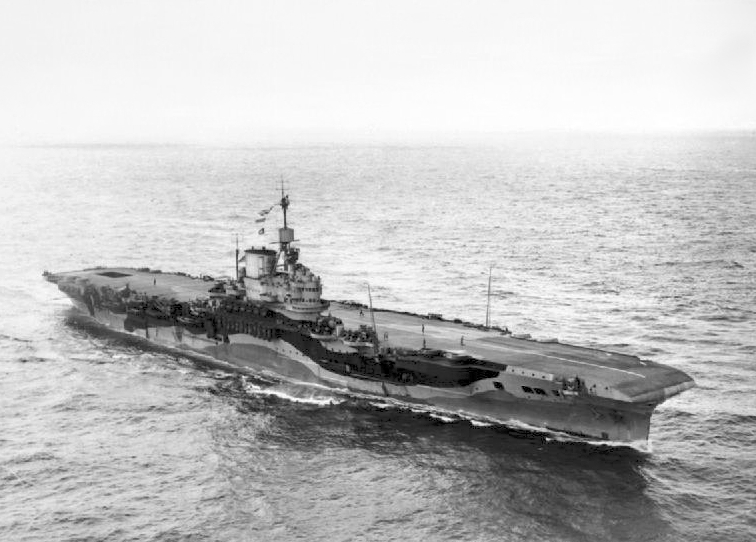
HMS Formidable, which launched three air raids on the Italians and sank Pola (and two other cruisers indirectly) at Matapan.
Sister ships to the rescue
Iachino, meanwhile, was completely unaware of Pola’s situation. He was informed inly at around 20:10 on 28 March. Learning this, he sent his screening force (Fiume, Zara, and four destroyers) back to protect Pola. HMS Orion detected Pola by radar, reported her location and British battleline by then was only 50 nmi (93 km; 58 mi) away, strating to close in, using their own radar as darkness fell. At 22:10, Pola was circa 6 nautical miles from Valiant when her lookouts spotted them, assuming they were the reinforcements, revealing her presence by firing a red flare. It took twenty minutes more before the British battleships were placed in the perfect spot, opening their searchlights. Zara and Fiume were hit and destroyed first, including the two destroyers as seen above, but Pola was left alone.
The boarding party
Captain C.V. Manlio De Pisa assumed he would be the next target, while still unable to return fire. He ordered to prepare scuttling, by opening seacocks and prepare to abandon ship. Ten minutes after midnight, HMS Havock at last spotted Pola in the dark, as she was still left without power. British destroyers rushed in, spotted Zara and torpedoed her along the way, and later joined Havock. Together, they prepared something rarely seen in a modern naval war, ath the age of radars: A boarding party. The idea could have been to take Pola as a war prize, and tow her to port. This would have been for Churchill, desperate for good news, quite a formidable propaganda coup. The last boarding action of the kind was from HMS Cossack, on the German supply ship Altmark in Norway, in 1940. Arriving, the destroyers observed the crew assembled on deck trying to warme themselves as they could. The remaining men and officers were assembled in the forecastle and officers destroyed sensible documents, preparing to surrender the ship, as they was nothing more to do. HMS Jervis approached carefully and boarded Pola, the party jumping into action in a fast and casualty-less assault, rounding up the surviving 22 officers and 236 enlisted men on board. Later, HMS Nubian torpedoed the ship at close range, helped by HMS Jervis which illuminated her. It’s when the situation is unclear. Pola’s magazines exploded allegedly because of explosive charges (prematurely?) detonated, and she sank at 04:03, on 29 March, with still apparently 328 men on board. There was no reason why the crews were not all evacuated properly before Nubian launched her torpedoes, so that point needs some explanations.
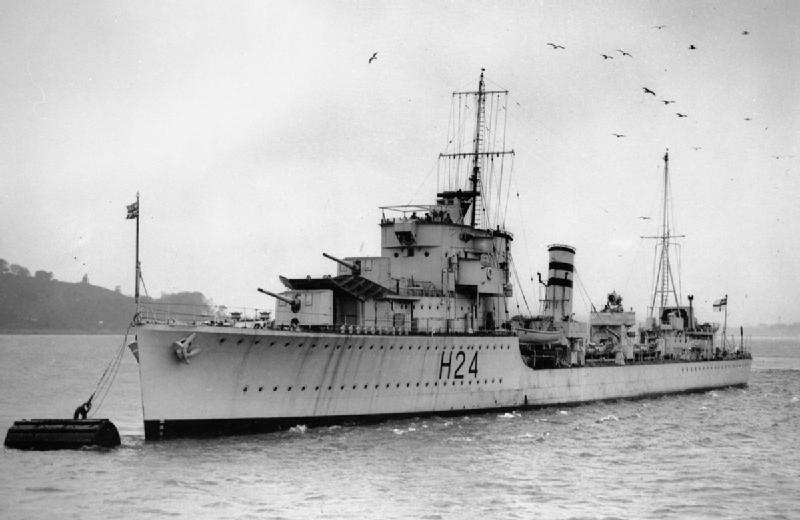
HMS Hasty, of the same type of the Havock, which spotted Pola in the dark.
Controversy debunked
Authors are divided however about facts following this torpedo hit, with much British propaganda since, to the point of making the situation absurd (and quite funny for RN crews). It was alleged that after the torpedo hit, most of the crew panicked, abandoned ship without waiting for instructions, but not before getting drunk to keep the cold out. Since Pola did not sank, the soggy sailors soon hauled themselves back up on board, stripped naked to avoid hypothermia. Some were discovered in that sorry state by a boarding party later (see below), and event speaking volumes about the discipline onboard. However, this needs to be debunked. Pola was torpedoed at 7:58pm after Formidable’s third strike, and eight strike counting land-based bombers. At some point, the crews thrown overboard ammunition for the 100 mm secondary battery, as steam from a broken pipe was mistaken for fire and it was quickly stopped and the remainder properly stored nearby to avoid potential explosions. Pola in fact had communicated her situation and was waiting for the rest of 1st Division to come back toe tow her. The crew managed to pump most of the war out and relight a boiler and she was was capable of 5 knots, but making too much smoke in the process, so the captain ordered to shut down it down later.
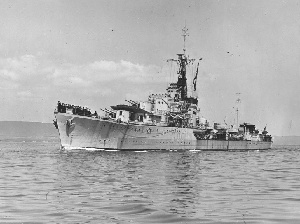
HMS Jervis, which boarded Pola, in one of the rare actions of the kind during WW2
Gunnery flashes were seen when British battleships opened fire, ambushing Zara and Fiume before they made it to Pola. The latter then was ordered cleared for action, with only her secondary battery, using backups for elevation and traverse, although it was soon determine there was no longer enough ammunition on board. By then the staff took to decision to open seacocks, at 11:15pm so three hours, 18 minutes after her torpedo hit. It was about 12:10 am when Havock discovered Pola, and fired briefly, starting a fire, which indeed, prompting indeed some crew member to jump into the sea. It was during the boarding party that British sailors found them again, naked but under blankets, and given wine because of hypothermia. Onboard Zara and Fiume, Main gun crews manned them all along, waiting for a possible firing order. Nevertheless, these guns were ill-prepared for night actions as they were not provided with flashless ammunition. The impression made by the situation on the British boarding party was probably inflated later as a funny anecdote, and reassuring the Navy in a sense for what they faced in the Mediterranean, where the advantage was not so clear-cut. It nevertheless fed a picture already born during operation Compass. These narratives were contradicted anyway by the sober British official reports of this night action.
Gorizia
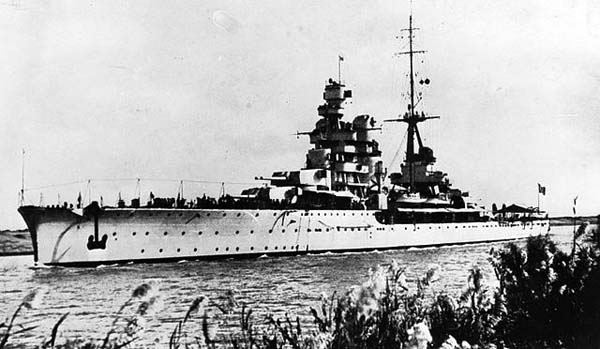
Gorizia was laid down at OTO shipyard in Livorno on 17 March 1930, was the last ship of the class, and sole survivor, at least until 1944, so she had the longest career. Launched on 28 December 1930, completed on 23 December 1931, commissioned with the 2nd Division (so separate from her sister ships for her whole career), she took part in naval exercises off Naples in August, in presence of King Victor Emmanuel III. On the 25 she became flagship of the division and participated in other naval reviews, in July 1933, while being transferred to the 1st Division, still as flagship, receiving her battle flag on 29 June 1934. She escorted the royal yacht Savoia to the east coast of Africa in October 1933, ending in Italian Somaliland. The 1st Division Commander swapped his flag to Pola on 31 December and back on 3 June 1935. Gorizia patrolled to Spanish waters in July 1936, evacuating Italian nationals from Gijón on 31 July-1st August, landed at Le Verdon-sur-Mer in France. She then headed for Germany and arrived in Kiel on 8 August for a naval review with the Graf Spee, Königsberg, and HMS Neptune. She represented Italy there during the 1936 Summer Olympics’s sailing events.
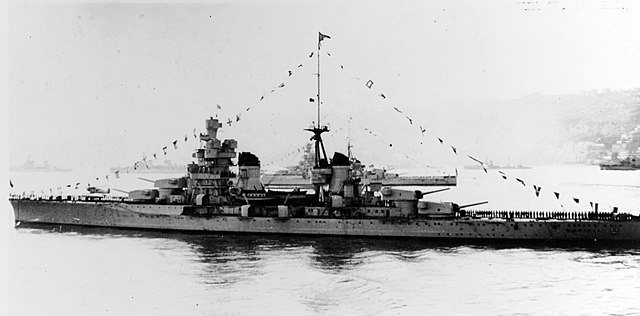
Gorizia at a pre-war fleet review
On 19 August 1936, Gorizia departed Kiel for Tangier and headed for Italy. However during that night, her forward aviation gas tank blew up for undetermined causes. The damage was serious enought that she headed back to Tangier for provisional repairs, then Gibraltar, arriving on 25 August for more thorough repairs in dry dock. This gave the occasion to British officials to board and examine the cruiser. They concluded she exceeded her nominal 10,000-ton displacement, but this did not led to any formal complaint. After repairs ended on 9 September, Gorizia headed for La Spezia, and more permanent repairs. This was over by November 1936. Newt followed a naval review for the Regent of Hungary, and she returned to normal duties as divisional flagship by May 1937, before another review on 7 June, and on 5 May 1938. On 7 March 1939, she intercepted and forced back to Bizerte a squadron of Republican warships, later interned in Tunisia and in 7-9 April, she supported the Italian invasion of Albania. She also took part in Navy Day festivities in Venice and spend the rest of early 1940 without notable event.
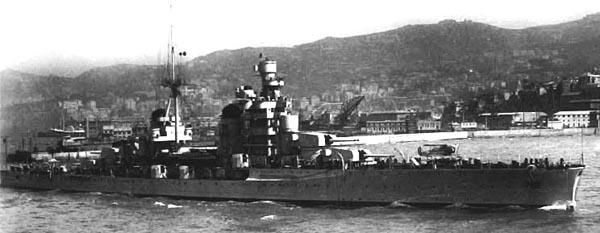
Gorizia underway, date unknown
1940 Operations: Calabria, Cape Spartivento
Gorizia was was in the 1st Division, 1st Squadron with sisters Zara and Fiume based in Taranto, and patroled off Crete, and by July she took part in the Battle of Calabria, but on the disengaged side of the Italian line, so she never fired. She was nonetheless later atacked by Torpedo bombers from HMS Eagle, but without hit. After the Italian battleships started to engage the British battleline, Gorizia and her division steamed ahead at the the front of the line, joining in the attack on Warspite, scoring no hits. While after a single hit on Giulio Cesare, reducing her speed to 18 knots, the Italian commander ordered to disengage while British cruisers attacked the Italians and the duel went on for some time, both sides staying at long range. Gorizia was never hit by the British cruisers.
On 30 July, the 1st Division escorted a convoy to Libya, followed by Gunnery training off Naples and a posting to Taranto. On the 31, the Division was out to incercept a british convoy (Operation Hats), without success and in early 7–9 September, the division was based in Palermo, and returned to Taranto on 11 September. Followed a gunnery training this month and the next and Gorizia was left unscaved after the night air raid on 11–12 November, her anti-aircraft crew claiming to shot down at least one Swordfish. Gorizia was sent in Naples by safety, taking part in the Battle of Cape Spartivento, duelling with British cruisers and shooting down a British plane. But her home base was later bombed, forcing her ti be relocated to La Maddalena in Sardinia, on 15 December 1940.
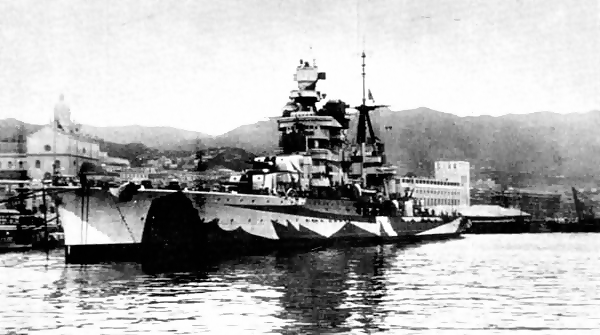
Gorizia painted in dazzle camouflage in 1942
1941 Operations
RN Gorizia returned to Taranto by late January 1941, training with Zara on 29 January before joining La Spezia for periodic maintenance, leaving the drydock on 7 May and replaced by Pola as flagship of the 1st Division. Meawnhile her three sisters were sunk at Cape Matapan on 28 March, deleting the 1st Division as a fighting force. Gorizia therefore was reassigned to the 3rd Division on 8 May, with Trento, Trieste and Bolzano. This was the only Italian heavy cruiser unit, now based in Messina, and tasked of convoy escort to North Africa. The first started from 26 to 28 May, another on 25 June, to Tripoli and back and another. On 23 August, however, the main fleet made a sortied to try to intercept Force H, but failed to locate it and returned. On 9–11 September, RAF and RNAS air strikes on Messina multiplied, Gorizia like the other making her anti-aircraft batteries talk each time, caliming palanes down or damaged. By the fall of September, the British launched Operation Halberd, another large convoy, and the Italian fleet departed on the 26th, but had to broke off when discovering the strength of the escort force. On 29 September, Gorizia departred alone to La Maddalena, but returned to Messina on 10 October, followed by another massive bombing of the port on 21 November. This time Gorizia was damaged by shell spinters, but this did not prevent her to make a sortie the same day for a convoy escort.
Battle of Syrte
The 16-17 December 1941 escort mission, faced a force of 5 British light cruisers and 14 destroyers escorting their own convoy to Malata. The Italian on paper thrown all they had at the time: 4 battleships (Caio Duilio and in 3 in distant cover), Emanuele Filiberto Duca d’Aosta, Muzio Attendolo, Raimondo Montecuccoli as the close covering force plus three destroyers, as as a distant cover, Trento, Gorizia, and 10 destroyers. Their convoy consisted in just three motorships and a single freighter. Both admiral, Iachono and Vian, wanted to avoid combat so basically they tanced each other with long range volley at 32,000 m (35,000 yd) while the British soon reterating under smoke and the italians broke off due to the lack of radar.
1942 Operations
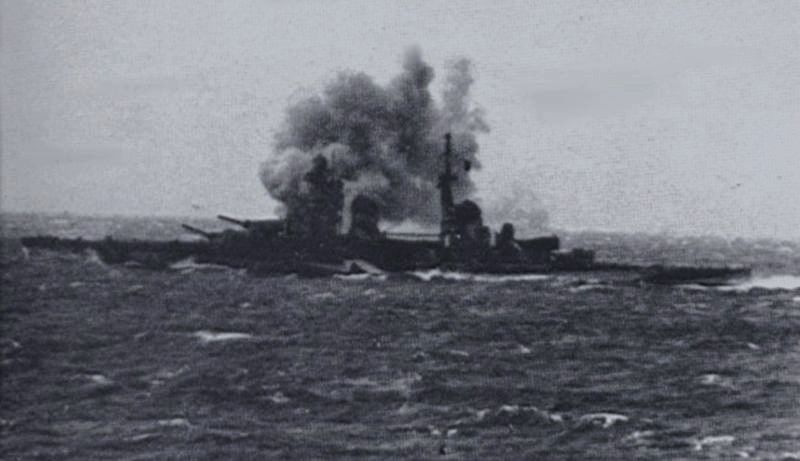
Gorizia firing her main battery during the Second Battle of Sirte
Gorizia hosted while in Messina on 25 January 1942, German Luftwaffe officer Generaloberst Bruno Loerzer. on the 30, she also hosted Prince Umberto II and Hermann Göring as the Germans organized the air defence of Sicily. Gorizia was back in action on 14 Feabruary, search for Allied shipping befotre being spotted and targeted by torpedo bombers and later ambushed by submarines, which all missed. On 21 February, the protected a convoy to Tripoli and on 22 March, took part in the Second Battle of Sirte: In this battle that took place that day, the italians mustered superior forces again, 1 battleship, 2 heavy cruisers (Trento and Gorizia), 1 light cruiser, 10 destroyers and 1 submarine, and arguably achieved victory, by having no casualties and their battleship slightly damaged; while they damaged three light cruisers, three destroyers and disabled two more. But the Italians failed to reach their objective and left the convoy unscaved. Both screening foces duelled with each others, and Gorizia was heavily engaged with British light cruisers and destroyers, at long range, the British ships using smoke to protect them. Gorizia due to this scored no hits, firing 226 main battery rounds. Due to this her barrels were worn out and relacement planned afterwards.
They were relined in Messina in early May and the ship was damaged by splinters ny air raids on 25-26 May and the next two days. The 28 saw her heading for Taranto, repulsing more air attacks underway. On 15 June the fleet was assembled to launched a sortie against another convoy to Malta (Operation Vigorous) and Gorizia lost a floatplane while soon after she had to fend off three British torpedo bombers attacks. Trento was less lucky than Gorizia and took a hit, was immibilized and later sunk by a submarine. On 5 July 1942, Gorizia, was the last of three Italian heavy cruisers in operations, sailed back to Messina where she hosted the 17 Umberto II. While en route to intercept a British convoy on 11–13 August, she was ambushed by a British submarine but evaded the attack. Meawnhile, Bolzano (now repaired) and Muzio Attendolo were both badly damaged. Gorizia, Trieste, and two destroyers returned to Messina and stayed inactive from August to december.
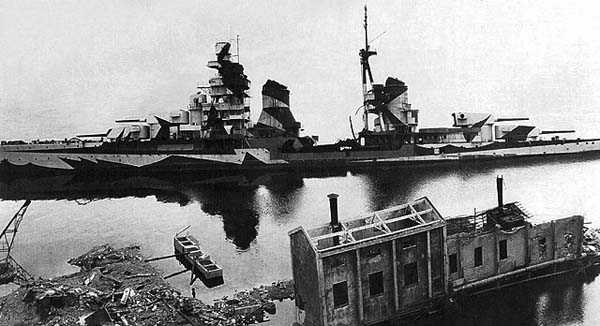
Gorizia abandoned at the end of the war in 1945.
1943 Operations
Allied bombing raids were so frequent, the Regia Marina decided to leave Messina for good. The 3rd division sailed on 9 December for La Maddalena (Sardinia), only to be targeted this time by USAAF heavy bombers, on 10 April 1943. Trieste was sank, Gorizia took three bombs hits. One bomb penetrated the rear superfiring turret, exploded inside and the other two went through the port deck abreast of the superstructure, while near misses breached the hull below the waterline. Damage control avoided flooding and Gorizia was able to steam out to La Spezia for comprehensive repairs, only to be bombed again her on 19 April (only splinter damage). By that time, the 3rd Division was disbanded, there was no Italian heavy cruiser left. Bolzano was indeed torpedoed and sank in August 1942.
Gorizia entered the dry dock in La Spezia on 4 May 1943 and she was still there when the September armistice was signed. Her commander initially ordered to flood the drydock and scuttle the ship when German troops arrived, but cancelled it as he realized the ship would not be of any use for them. They nevertheless captured it, and later towed her to free the drydock and achor her in the harbor. A raid on 21–22 June 1944 by British and Italian frogmen using ‘Chariots’ (manned torpedoes) infiltrated and reached Gorizia and Bolzano, to sink both. The idea was to prevent the Germans using them as blockships. Gorizia however remained afloat, while heavily listing. She was captured by the allies on April 1945, discarded afterwards, stricken and BU in situ in 1947.


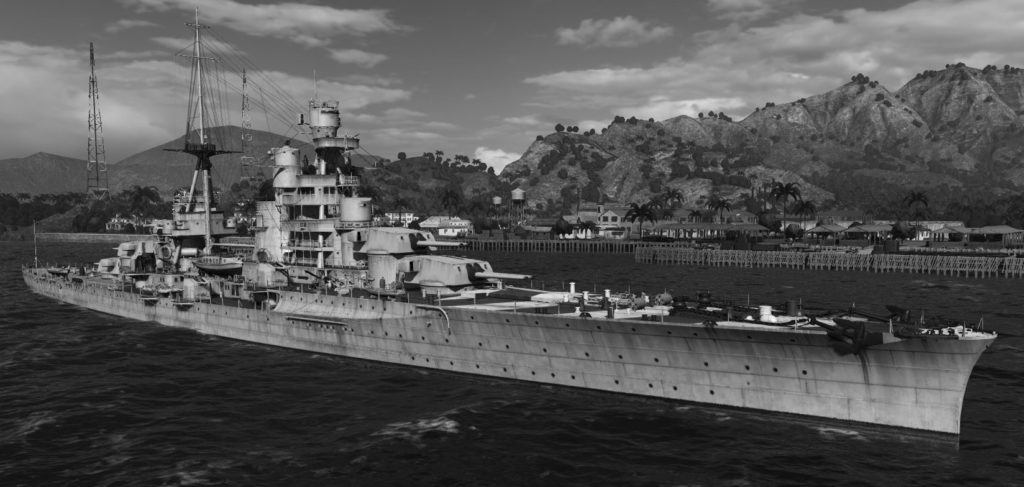
 Latest Facebook Entry -
Latest Facebook Entry -  X(Tweeter) Naval Encyclopedia's deck archive
X(Tweeter) Naval Encyclopedia's deck archive Instagram (@navalencyc)
Instagram (@navalencyc)





 French Navy
French Navy Royal Navy
Royal Navy Russian Navy
Russian Navy Armada Espanola
Armada Espanola Austrian Navy
Austrian Navy K.u.K. Kriegsmarine
K.u.K. Kriegsmarine Dansk Marine
Dansk Marine Nautiko Hellenon
Nautiko Hellenon Koninklije Marine 1870
Koninklije Marine 1870 Marinha do Brasil
Marinha do Brasil Osmanlı Donanması
Osmanlı Donanması Marina Do Peru
Marina Do Peru Marinha do Portugal
Marinha do Portugal Regia Marina 1870
Regia Marina 1870 Nihhon Kaigun 1870
Nihhon Kaigun 1870 Preußische Marine 1870
Preußische Marine 1870 Russkiy Flot 1870
Russkiy Flot 1870 Svenska marinen
Svenska marinen Søværnet
Søværnet Union Navy
Union Navy Confederate Navy
Confederate Navy Armada de Argentina
Armada de Argentina Imperial Chinese Navy
Imperial Chinese Navy Marinha do Portugal
Marinha do Portugal Mexico
Mexico Kaiserliche Marine
Kaiserliche Marine 1898 US Navy
1898 US Navy Sovietskiy Flot
Sovietskiy Flot Royal Canadian Navy
Royal Canadian Navy Royal Australian Navy
Royal Australian Navy RNZN Fleet
RNZN Fleet Chinese Navy 1937
Chinese Navy 1937 Kriegsmarine
Kriegsmarine Chilean Navy
Chilean Navy Danish Navy
Danish Navy Finnish Navy
Finnish Navy Hellenic Navy
Hellenic Navy Polish Navy
Polish Navy Romanian Navy
Romanian Navy Turkish Navy
Turkish Navy Royal Yugoslav Navy
Royal Yugoslav Navy Royal Thai Navy
Royal Thai Navy Minor Navies
Minor Navies Albania
Albania Austria
Austria Belgium
Belgium Columbia
Columbia Costa Rica
Costa Rica Cuba
Cuba Czechoslovakia
Czechoslovakia Dominican Republic
Dominican Republic Haiti
Haiti Hungary
Hungary Honduras
Honduras Estonia
Estonia Iceland
Iceland Eire
Eire Equador
Equador Iran
Iran Iraq
Iraq Latvia
Latvia Liberia
Liberia Lithuania
Lithuania Mandchukuo
Mandchukuo Morocco
Morocco Nicaragua
Nicaragua Persia
Persia San Salvador
San Salvador Sarawak
Sarawak Uruguay
Uruguay Venezuela
Venezuela Zanzibar
Zanzibar Warsaw Pact Navies
Warsaw Pact Navies Bulgaria
Bulgaria Hungary
Hungary

 Bundesmarine
Bundesmarine Dutch Navy
Dutch Navy Hellenic Navy
Hellenic Navy Marina Militare
Marina Militare Yugoslav Navy
Yugoslav Navy Chinese Navy
Chinese Navy Indian Navy
Indian Navy Indonesian Navy
Indonesian Navy JMSDF
JMSDF North Korean Navy
North Korean Navy Pakistani Navy
Pakistani Navy Philippines Navy
Philippines Navy ROKN
ROKN Rep. of Singapore Navy
Rep. of Singapore Navy Taiwanese Navy
Taiwanese Navy IDF Navy
IDF Navy Saudi Navy
Saudi Navy Royal New Zealand Navy
Royal New Zealand Navy Egyptian Navy
Egyptian Navy South African Navy
South African Navy






























 Ukrainian Navy
Ukrainian Navy dbodesign
dbodesign